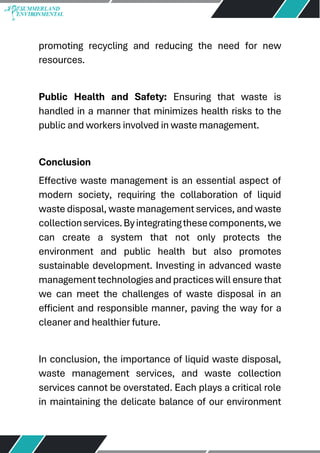Getting The Reclaim Waste To Work
The 8-Minute Rule for Reclaim Waste
Table of ContentsSome Known Details About Reclaim Waste The Only Guide to Reclaim WasteReclaim Waste - TruthsThe smart Trick of Reclaim Waste That Nobody is Talking AboutExcitement About Reclaim Waste
Check out the types, occurrences, and kinds of fluid waste. Domestic sewer waste refers to the waste and items from a household septic storage tank. This kind of waste is developed by people in houses, colleges, and other structures. This only includes septic tanks that have a drain field. The proper monitoring and disposal of domestic sewer waste need fluid waste to be transferred to a sewer treatment plant where the correct techniques and equipment are put on purify and get rid of waste.
Commercial waste frequently includes prospective risks, such as flammable materials or a combination of liquid and strong waste items, and requires a much more advanced and thorough disposal process. The disposal of commercial waste normally involves the filtration of waste before transport to make certain risk-free and appropriate disposal. Industrial waste is produced from by-products and drainage of commercial procedures and production.
This kind of waste can not utilize the exact same sewer monitoring transport or processes as septic or commercial liquids. The hazardous waste management process needs the examination and screening of fluid waste prior to it undertakes the disposal procedure (liquid waste removal). Drainage waste is the fluid waste that originates from overflow and excess stormwater in extremely booming locations or cities
Drainage waste can cause contamination and flooding if not taken care of properly. Find out more regarding sewer cleaning and waste management. Guaranteeing proper waste management can prevent disasters and reduce ecological injury. Both people in property settings and professionals in business or manufacturing markets can benefit from understanding the procedures and guidelines of liquid waste management.
The Single Strategy To Use For Reclaim Waste
Contact PROS Solutions today to learn more about our waste management and disposal services and the correct methods to look after the liquid waste you create.
(https://writeablog.net/reclaimwaste1/reclaiming-resources-a-comprehensive-guide-to-industrial-wastewater-treatment)Do you understand what occurs to your water when you pull the plug, purge the bathroom or drain pipes the cleaning device? No? Well, it deserves understanding. This so-called 'wastewater' is not just an important source yet, after treatment, will certainly be released to our land, rivers or the ocean. Used water from commodes, showers, baths, cooking area sinks, laundries and commercial processes is referred to as wastewater.

water utilized to cool down machinery or tidy plant and equipment). Stormwater, a kind of wastewater, is overflow that moves from agricultural and city areas such as roof coverings, parks, gardens, roadways, courses and gutters right into stormwater drains, after rainfall. Stormwater streams neglected straight to neighborhood creeks or rivers, at some point reaching the ocean.
Reclaim Waste for Beginners
In Queensland, a lot of wastewater is dealt with at sewer therapy plants. Wastewater is carried from residential or commercial websites via a system of sewage systems and pump terminals, called sewerage reticulation, to a sewage treatment plant. Local governments build, keep and run most sewer treatment plants. Operators are licensed under the Environmental Protection Act 1994 to discharge treated wastewater at an acceptable environmental standard into waterways.
The Division of Natural Resources encourages city governments about managing, operating and keeping sewage systems and treatment plants. In unsewered areas, local federal governments might need homeowners to install individual or household sewer therapy systems to treat domestic wastewater from commodes, cooking areas, washrooms and washings. The Department of Natural Resources authorizes using family systems when they are shown to be efficient.
In some brand-new neighborhoods, therapy of some stormwater to eliminate litter, sand and crushed rock has started using gross toxin traps. Wastewater therapy happens in four stages: Gets rid of solid issue.
Wastewater after that streams into big containers where solids work out and are gotten rid of as sludge. Grease and residue are skimmed from the surface. Utilizes little living organisms recognizes as micro-organisms to break down and Click This Link eliminate remaining dissolved wastes and great particles. Micro-organisms and wastes are included in the sludge. Removes nitrogen and phosphorus nutrients that might create algal blooms in our rivers and intimidate aquatic life.
Not known Details About Reclaim Waste
Nutrient removal is not offered at all sewage treatment plants due to the fact that it calls for pricey specialized tools. Clear fluid effluent created after treatment might still include disease-causing micro-organisms - liquid waste removal.

A lot of wastewater flows right into the sewerage system. Under the Act, neighborhood governments administer authorizations and licences for eco relevant tasks (ERAs) entailing wastewater releases that might have a neighborhood impact.
Some Known Details About Reclaim Waste
Otherwise, samples are taken for lab evaluation. Commonly several tests are needed to develop the degrees of each of the different contaminants such as oils, hefty steels and pesticides in water. Tracking supplies valid information about water high quality and can validate that permit conditions are being met. The info gotten via monitoring offers the basis for making water high quality choices.